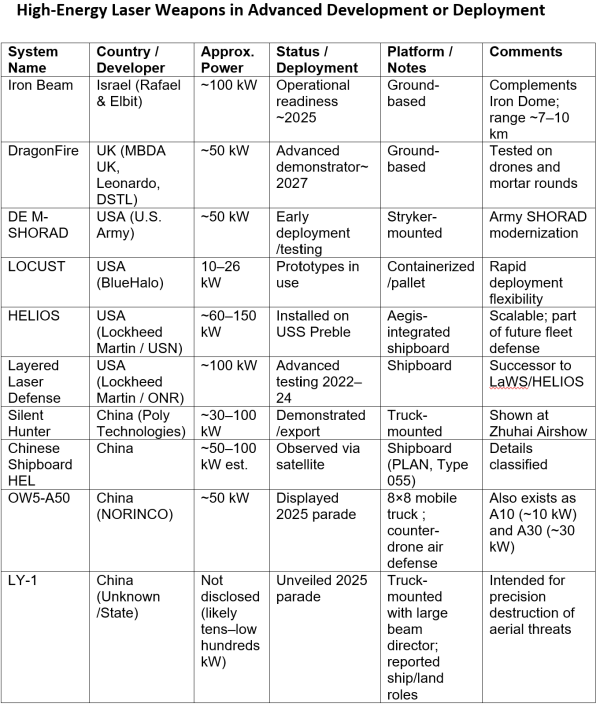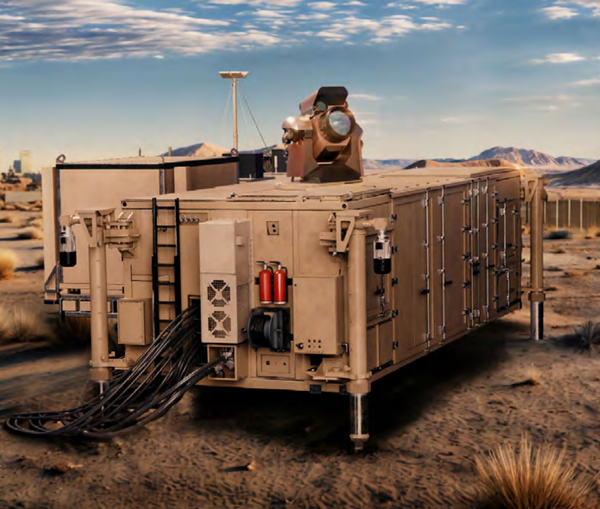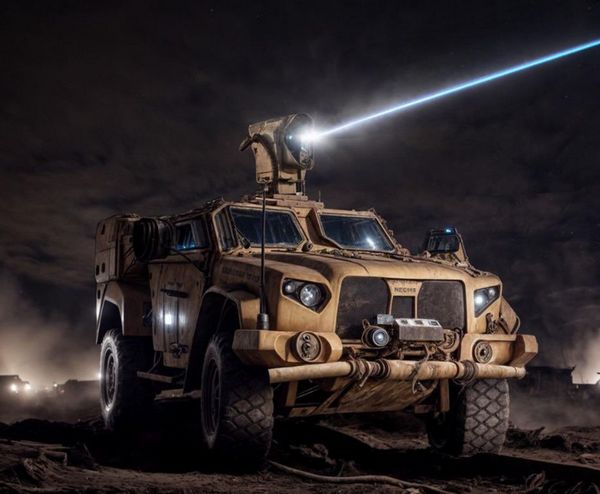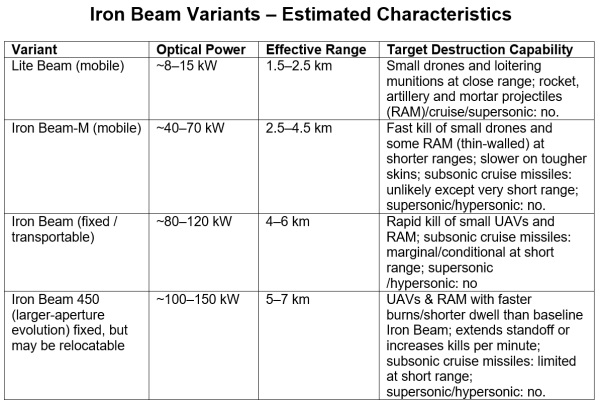High‑energy laser weapons (HELs) are moving rapidly from experiments and prototypes toward operational military deployment. In 2025, several countries have demonstrated or unveiled HEL systems capable of intercepting drones, rockets, mortar fire, and precision munitions. Among the most newsworthy are Israel’s Iron Beam, now declared imminently operational, and China’s newly revealed LY‑1. This article provides an overview of HEL technology and some details on Iron Beam, the laser weapon most likely to see operational use in the near future.
HEL weapons function by directing powerful laser beams onto a target until it is neutralized by structural failure or destruction of sensors. Their advantages include very low cost per shot (once the system is built), almost instantaneous “time of flight,” high engagement capacity, and minimal logistics compared to missile interceptors. But there remain technical hurdles: power generation, thermal dissipation, atmospheric effects (haze, dust, rain, humidity), accurate tracking/aimpoint maintenance, system mobility, durability, and cost of investment. Prototype systems have demonstrated the ability to destroy aerial targets such as drones, rockets, artillery projectiles, and some cruise missiles. More powerful systems are planned which could even engage ballistic and hypersonic missiles.
Racing Beams
Leading military powers are racing to develop and deploy HEL weapons for two main reasons. 1) The technology has matured to enable effective targeting and destruction of aerial threats, and 2) the growing danger of drone attacks overwhelming conventional defensive systems. The combination of high-level laser power, automated beam control and aiming, and better thermal/power integration moved HELs from lab curiosities to operational tools now being installed on ships and deployed for ground air-defense roles. At the same time, precision-guided drones have become a major threat on the battlefield. The ability of large numbers of inexpensive drones to overwhelm conventional defenses called for a new class of weapon that would not be limited by a supply of kinetic munitions. The HEL, with its rapid firing capacity and inexhaustible “ammunition” meets that need. At present, Israel and China are leading the HEL arms race, with likely deployment of HEL weapons this year. Other nations will not be far behind.

Power Play
The technology of HEL weapons is highly complex, involving laser physics, optics, computerized fire control, and networked battle management. All of this complexity can be reduced to a single engineering trade-off: power versus cost. The ability of an HEL to destroy aerial targets depends on the energy in the laser beam. An HEL with 5-30 kilowatts of power can disable or destroy small drones, simple rockets and artillery and mortar shells at close range. Increasing beam power to 50-100 kW enables the destruction of large drones and projectiles at longer ranges, and some subsonic cruise missiles. To destroy the most difficult targets, supersonic and hypersonic missiles, 300-1,000 kW laser power is needed, depending on the speed of the missile. As the capability level of the HEL system increases, the cost, power requirements, and size increase nonlinearly, limiting the most powerful systems to fixed deployment on land or on large ships.
Iron Beam
Israel’s Iron Beam system is likely to be the first HEL weapon system to see combat. Israel currently faces the threat of short-range rocket attacks and the growing danger of drone attacks. Hezbollah, Hamas, Iran, and Yemen have all struck Israel with combinations of these weapons, and this is a persistent threat. Iron Beam is intended to strengthen defenses against future attacks by augmenting the Iron Dome system. It will do so by reversing the unfavorable cost equation between Iron Dome’s Tamir interceptor missiles and attacking drones. The cost per “shot” of the Iron Beam laser is just a few dollars, versus the $50,000-$100,000 estimated cost of each Tamir missile. Using the Iron Dome radar to cue targets, Iron Beam will take out most incoming drones and the Iron Dome missiles will be reserved for more difficult targets.
Iron Beam – a brighter idea
Iron Beam will be deployed as a family of HEL weapons, with lower-powered systems capable of vehicle installation for full mobility. The more powerful versions will likely be fixed, but relocatable in containerized modules. Some of these variants may be exported, since Rafael, the maker of Iron Beam has displayed the equipment at arms shows.
Lite Beam – HEL on wheels
Devilish Details
HELs are not miracle weapons; their effectiveness is limited by physics, operations, and logistics.
-
Atmospherics: Fog, smoke, dust and heavy aerosols can severely cut transmission and enlarge the spot; rain degrades performance but is usually less damaging than fog/smoke.
-
Throughput & geometry: Each emitter engages one target at a time and needs seconds of dwell; line-of-sight only, with effectiveness dropping at long slant ranges, in turbulence, or against fast-rolling targets.
-
Target discrimination & deconfliction: Risk of misidentification means friendly/civilian drone operations may be restricted during HEL use
-
Sensor/cueing dependence: Lasers rely on external radar-based command and control for wide-area detection; those nodes are vulnerable to attack or jamming.
-
Power & cooling logistics: Sustained fire demands large generators, fuel, and chillers; these support assets are bulky and targetable.
-
Maintenance & durability: Optical windows/coatings, beam directors, pumps, and filters require frequent inspection/servicing.
-
Adversary countermeasures: Obscurants, reflective/ablative coatings, spinning/tumbling, and decoys can force longer dwell, waste shots, or deny tracks.
In real-world combat operations, HEL weapons will confer an advantage to defenders against aerial attack, but this could be offset by countermeasures and the general “friction” of war. As armed forces adopt and adjust to the presence of HEL technology, laser weapons are unlikely to be decisive in future conflicts.
Conclusion
High‑energy laser weapons are no longer a science fiction fantasy. Systems like Israel’s Iron Beam are about to enter operational service, and will likely soon be used in combat. While many technical and environmental challenges remain for HELs, their operational envelope is steadily expanding. In the Middle East, HELs are likely to change the calculus of defense: increasing the cost and difficulty of saturation attacks, giving defenders more sustainable options, and offering new doctrine and deployment patterns. The coming decade may see laser defense shift from novelty to necessity, with the prospect of yet another costly and futile round of worldwide arms racing.





Indeed. The rate of fire is a huge problem. It can be very easily be overwhelmed by a large salvo.
Another consideration is that this might work somewhat for Israel in their dry Mediterranean climate, but if you move to places with clouds, rain and snow, it is a very different calculus.
Also, because the laser requires so much power, the heavy duty such systems will be stationary or at least with a very heavy footprint, and they will literally glow to any enemy reconnaissance assets. And because they are good at taking out slow targets but powerless against supersonic and hypersonic missiles, they will be quickly taken out by a serious opponent. And given the low rate of fire problem, they can be taken out even by the slow drones they are supposed to engage too.
Bulky and easily targeted–say no more.
And SC fun fact–Nobel winner and co-inventor of the laser Charles Townes did his undergraduate in nearby Greenville, SC.
He later said his only memories of South Carolina were of red dirt (we prefer “iron enriched”). He did eventually come back to be celebtated by his alma mater.
I’m wondering about a drone swarm of 1,000 drones coming at a target from 360 degrees. If one drone takes out the truck mounted laser, then it’s home free for the rest.
In combat situations, ‘taking out’ the truck laser will probably be the task of the ground soldiers. RPGs, IEDs, satchel charges, etc. etc. The most damaging effect on the offense will be in the blinding of surveillance drones. Welcome back the fog of war.
Well, that depends on the capacity of the laser’s energy supply. A few tens of kWs every few seconds are going to take more than a few Duracells. Also it’s likely that more than half a major drone swarm will be decoys, there just to ensure that the defenders run out of ammunition before the armed drones reach the target.
I worked on surface waves with an 8W laser back in the ’80s, and the cooling for that required 30 gallons/minute of water at zero C. I don’t know if the laser cavities have gotten considerably* more efficient since the, but assuming a 100x efficiency gain, an 80 KW laser is going to require 3,000 gpm. Plus, the lifetime of the laser cavities was not great.
I know we’re forty years on, but I’m throwing this out as a reference point because the power dissipation does not change.
* not saying exponentially, since everything is exponential – if you use the right exponent.
It’s a dangerous weapon because a tiny amount of deflected or reflected light is enough to blind perhaps your own troops.
Or, looking on the bright side (no pun intended), deliberately blinding enemy troops. I’ve seen that proposal floated a long time ago, it wouldn’t take that much power to damage a retina. Not sure why it was abandoned, possible friendly fire damage, bad visibility close to the ground?
I’d guess 99% there’s some operational reason or escalatory logic nobody likes, but I think dazzlers aimed at human soldiers are forbidden by one of the current arms conventions.
Sensors are totally fair game though IIUC
Reading through, I was going to say that this sounds like something a few smoke bombs could thwart, but you beat me to it. And maybe I’ve watched too many roadrunner coyote/cartoons, but what about countering these with a mirror? This seems more like some nerdbox pipe dream than an actually effective weapon.
Random speculation alert!
Would a reflective coating on a prismatic shape that deflects and disperses light be of use to diminish or defeat a laser?
Such a surface may aid in aerodynamics similar to bumps on a golf ball.
Ok, done.
A reflective or ablative coating diminishes the heat transfer, but these are enormously powerful laser beams, so you are just buying a short time before the beam burns through. It might be enough to protect a fast missile, but it won’t save a slow drone.
I think this becomes a design decision.
There is a lot of work being done in reflective surfaces that can handle a continuous high energy laser source. It appears mainly to work using materials that are both highly reflective with highly efficient heat dispersion.
ceramics?
Since we’re speculating …
Three plane mirrors arranged as the three faces around one vertex of a hollow cube will reflect any beam right back the way it came. Somebody might try that.
No mention of the effect of these weapons on “soft targets,” ie. humans. Vehicle mounted versions could be used to blind or disable soldiers. A carriable pulse laser weapon has been a trope of science fiction ‘adventure’ stories for decades. The power source is the key. When room temperature superconducters are perfected, that might become possible.
Oh what a wonderful world will science bring us!
I recall, in the early stages of the genocide, reports of a new weapon being used on Palestinians… them bursting into flame and becoming desiccated, with no discernible vector of assault. Was very spooky at the time, perhaps this laser is it?
Don’t underestimate the power of discontent in the PLP let alone the non party liberal centre and left.
The LDs really are not going to risk sacrificing their party of protest mantra on the issue of compulsory ID.
Wrong thread. But the two themes do bleed into each other in a BLACK MIRROR-esque, ‘Most Hated in the Nation’ kind of way.
There are 5-7% without smart phones.. so maybe 4m people.
“…will do so by reversing the unfavorable cost equation between Iron Dome’s Tamir interceptor missiles and attacking drones. The cost per “shot” of the Iron Beam laser is just a few dollars, versus the $50,000-$100,000 estimated cost of each Tamir missile.”
The article did not mention the cost of the iron beam itself or other laser devices. I suspect it is a good bit more than a few hypersonic missiles. An effective attack on the beam device might include some drones with smoke bombs and a few missiles. Just striking the cooling units would probably make the laser disabled and would then be more easily completely destroyed. Now if the laser beams are cheap to build, about the same as a few hypersonic missiles, than maybe they will become commonly used. I have no idea but I’d guess anything custom made in the west is going to cost more than a few hypersonic missiles rolling of an assembly line in China or Russia.
The HEL system’s “reducing costs per shot” is just a sales pitch to convince governments to invest into another “wonder weapon” to increase spending by the MIC. If they are found to be easily destroyed or disabled, so much the better since that means more spending on additional defensive systems. The MIC’s engineering developments are not about cost savings, but rather to keep the flow of money going to MIC systems that fail and must be replaced, or require high maintenance costs. And of course our financialized economy (whose banks own the politicians) supports these boondoggles because war expenditures create debt. And as Michael Hudson points out – the goal is to extract the maximum surplus from society via rents (interest on debt), not to actually protect society.
Not even the most powerful existing models of Iron Beam are capable of taking out hypersonic missiles, and 3x to 10x the laser power would be required for that.
So the obvious attack strategy is to send in cheap recon drones to ID the location of the fixed Iron Beam units. Power must come from the grid or else dedicated gas generators, which can likely be sussed out using infrared imaging.
Using those co-ords, take out the fixed units with hypersonic missiles, and then send in more drones.
Only the mobile units would then survive, and they have a range of just 5 km. For comparison, Israel is about 420 km in length and 115 km across at the widest point.
During the Twelve-Day War this June, Iran didn’t target Israel’s power grid. If Israel tries to start another war against Iran, the latter might not be kind to the Israeli power grid. They would then quickly find themselves in the dark, with only the various Iron Beam units flashing helplessly against incoming hypersonics.
You already have missiles that home in on radar emissions like the AGM-88 HARM so you would expect a new class of missiles to home in on lasers being used from fixed positions.
What happens if the cheap drone sprays “chaff”….. maneuvers? What about if the AI running the sensor-battle management algos failed physics I?
Thermal seekers! No matter how much cooling if the “lens” is pushing 100kW there will be a heat signature like a flash bulb.
The “efficiency” of turning amperage into laser energy suggests a big generator set. Which also has a heat signature.
Several “kill the system” damage modes to attack.
And each tactical/training shot may be cheaper than a guided missile but how many shots before the thing is neutralized, and the investment destroyed.
Cost per shot based on “ROI” on investment may be pretty large.
Then if the target maneuvers the probability to kill (Pk) declines.
Evasive maneuvers Mr Sulu!
I can imagine successive drone waves, each spreading a reflective chaff/smoke cloud that protects the next wave as it approaches closer. Or here is a novel idea—drones flying at the deck to target the laser (or its power umbilical)! Sure, you can put it on a mountaintop, but then it has a long power line that is susceptible to drone attack.
My SWAG is that adaptations of ultra-cheap drones will evolve faster than the uber-expensive, delayed delivery new laser wonderwaffen (probably built with rare earths and other components that China is not exporting).
Given the Ukraine track record for Western wonderwaffen, I see more military stock valuation advantages than military advantages.
Exactly. It seems Iron Beam uses a fibre laser, in which the optical medium is doped with rare earths such as erbium, ytterbium, neodymium, etc.
And regarding Erbium:
A bit late to the party, but I am semi-amazed that the Russians haven’t been mentioned. I mean, they’ve literally been deploying some sort of a laser system as part of their anti-Ukrainian-drone defenses, and have released videos of shoot-downs in their nightly news programs. Months ago.
Incidentally, I don’t think it’s the “Peresvet” system they’d had since the 2010s, at least not in its original form. “Peresvet” was more of an anti-satellite weapon, whereas the new anti-drone project – I believe – is much, much smaller and less powerful, and is officially termed called “Posoh” (“walking stick”). Effective range is said to be 500-700 meters, kill videos show that 2-3 seconds is enough to burn through an aircraft-type drone completely. There are claims that the system has shot down FPV drones (with photos of the wrecks), but I haven’t seen an FPV kill video yet. For the technically minded, it’s an Ytterbium fiber laser of some description, at least according to public sources.
Moreover, literally two days ago Russian news sources reported that the “Posoh” laser has now been tested as a mine disposal device, and the manufacturer is now seeking proposals – from other companies – for some sort of a robotic vehicle to plop the thing on which the sappers could use in the field.
All a long way of saying, there is at least one country out there that’s rushing this technology onto an actual battlefield. I suspect there will be quite a few lessons learned in a year or two…
“Just one more wunderwaffe bro, I promise it will finally make apartheid sustainable forever, I promise bro”
So, do the Data Centers for AI get all the new power, or the lasers? I am confused.
Not to mention that all the New Power coming on line seems to be a lot of talking one’s book and promotional activity.
All the energy and resources we put into killing each other. That DEFINITELY is Priority One.
We, such as we are, are sooooo phucked.
Longtime lurker, had to post because, well, I worked on one of the military’s early experiments on laser propagation during the “Star Wars” era in the 80s.
Granted, I’ve been out of that area since the end of the 80s, but physics doesn’t change.
Laser is collimated light. Meaning it’s incredibly focused at the source. However, *any* atmosphere distorts the beam. Moreso if it’s cloudy or raining. We worked on the physics of measuring the distortion as the targeting beam bounced back and basically pre-distorting the beam with a mirror with actuators on it so the atmospheric distortion resulted in a collimated beam again at the target.
Problem was, the sensors were necessarily very sensitive, and something like a plane passing the beam with its lights would damage the sensors. We never did experiments during the day, only at night. You also had the issue of laser power necessary to take out a target in an at-scale device through an always-changing atmosphere.
Years later, the experiments were declassified, so it’s common knowledge in physics what the scientists did. But physics is stubborn, and there really was no way to get to a system that could deliver enough power to the target as long as your sensor system had to read through the atmosphere. As for “tested”….well, any reader here knows that contractors will finagle their test so it shows results. We heard stories about contractors and how they stacked the deck on their tests with missile defense systems of all stripes (smart rocks and brilliant pebbles, oh my). I would completely take any “We’re about to deploy this any day now” on the level of fusion being right around the corner.
It’s kind of synchronous the way this thread popped up around the same time as the one about SMRs, because there are contractors selling the government and businesses magic beans all over the place.
tl;dr – the physics of managing atmospheric distortion for the delivery of collimated light (lasers) through the atmosphere makes it incredibly difficult and impractical for deployment. But I’m sure defense contractors are making their best effort at delivering a weapons system that isn’t as described on the tin – like a lot of helicopters and planes. Or maybe the processing side of things has changed, and getting a larger laser likely became less expensive.